Emergency Power at Home- Why, What and How
By Joni Johnson
When the power goes out, it is very nice – and could be life-saving – to have a back-up source of electricity. Power supplies can be battery packs that are charged when there is power and used when there isn’t, or they can be battery packs attached to an independent source of electricity, like solar panels or car batteries.
Tom and I were very devil-may-care about getting a generator until the second power outage this year. Because of a need to keep some health machines going and the desire to see in the dark, we started looking into options for power supplies that would work here on campus.
Gas: For reasons of safety, RVM does not allow gas or diesel generators in our homes. If someone needs to be hooked up to electricity during a power outage, their main option is to be moved to the Manor for an electric hook-up to the emergency generator there.
Solar: After simple stored-power battery backups, the next and most viable choice is solar powered energy, and there seem to be a lot of these power supplies on campus. After inquiring, I was contacted by a number of people directly and others gave me names of people with this equipment. The big questions are, what do you want to charge, how heavy do you want the machine to be, and how much do you want to spend? All of the batteries discussed in this article can be charged from your electric socket while you have power, from solar panels, or from a 12v car charger.
| Important – before you buy a power supply, make sure that it will work with the equipment you are interested in using. Voltage – AC or DC? All of these batteries do have both options but some of the less expensive ones might not. The Watts (power requirement) – if it doesn’t tell you, multiply Volts times Amps. Watt-hours of the supply will tell you how long it will power an appliance of specific wattage. For example, most home medical gear (CPAP, oxygen concentrators) will run on 12 volts DC, although you may need some accessories, but air purifiers are AC only, and some power supplies do not have AC output. |
Small Power Supplies –
1. David Drury bought a setup from Amazon with an 80-watt solar panel strip (which he can hang from his back deck), and a 296 watt-hour storage battery. It weighs 6.6 lbs.

In his words, “I can charge all kinds of small electronic appliances — up to laptops — as well as batteries for flashlights etc. The storage battery is very versatile, produces both AC and DC current, and even includes a 12-volt attachment for connecting to car batteries. The important point (or one of them) is that using the solar panel in conjunction with a storage battery provides a lot more flexibility. You can charge things when the sun isn’t shining, and take maximum advantage of the sun when it IS shining — whether or not you’ve got anything that immediately needs charging.
If I had any buyer’s remorse, it would be that I got the 80 watt rather than the 100 watt panel (which is 6 feet long, as opposed to my more convenient 4 ft panel). Likewise, the smallish battery unit which would probably not be enough to run an oxygen concentrator. The next higher battery pack is 504 watt -hours.
His solar panels are connected and can be folded into a briefcase. They can be hung as he does or can be mounted at an angle of 40 degrees with their kickstands for better efficiency.
- Keith Maxfield wanted to buy locally and wanted a machine with the smallest possible footprint and with a collapsible handle so that he could keep it in his RV. He chose a Goal Zero Yeti Lithium 500X Portable Power Station.
He also chose a 4 panel connected 100 watt solar panel by Goal Zero, called the Nomad 100, which can fold up.
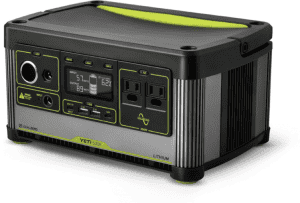
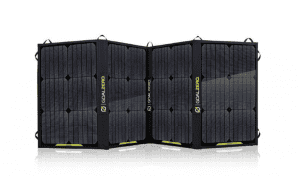
Medium Power Supplies
Tom and I wanted a higher capacity battery, but I needed to be able to carry it. We had to run a battery-powered oxygen concentrator (how many watts?). With a lot of help from Ron Constable, I ended up buying a Jackery 1000 package which included two 100 watt solar panels. The solar panels charge the battery from 0 to 100% in 8 hours in full sun. In our case, Tom’s battery powered oxygen concentrator could last about 10 hours on the battery pack. We have a charger that can charge one of the two concentrator batteries separately, which leaves a lot of room for charging other things like iPhones, iPads and computers. We should also be able to light one lamp, although we did buy a battery-operated lantern. The Jackery 1000 weighs 22 pounds and is fairly easy for me to carry. I bought from Amazon because Home depot’s Jackery was listed as the 880 and in fact only ran 880 watt-hours. When I searched for their 1000, it was significantly more money.
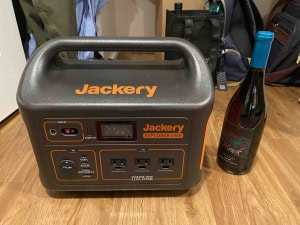
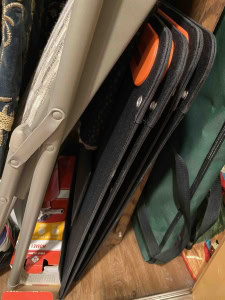
You can see the size of the battery compared to a bottle of wine and how easy it is to store the two panels in a closet. This is what it looks like open.
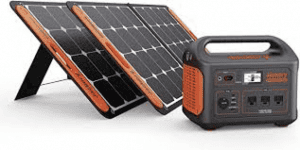
Larger
Bill Anderson has a Jackery 1500 plus the four 100 watt panels included in his package. The Jackery 1500 wasn’t available on Amazon, so he bought it through the Jackery company itself. It weighs 35 pounds. With the 4 solar panels you can recharge the battery in 4 hours of sunlight.
This is what it looks like out on the trail:
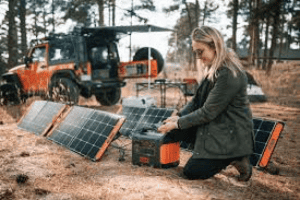
Bill also has a Tesla which can provide electricity, and can have him living the life of Riley for weeks on end without the need for any other power source. With that, he could use his coffee maker, a small refrigerator, an electric frying pan and a toaster.
If you have or want a Tesla, he is the man to talk to about what it can do for you in a power outage.
Really Large
There are other people on campus who have much larger batteries. For example, one person has a Goal Zero Yeti 3000X battery plus two 200 watt solar panels that will cost around $3000 plus the panels, but will run things for a significantly longer period of time. However, it is bigger and heavier (69.78 lb). The Yeti 3000 comes with wheels.
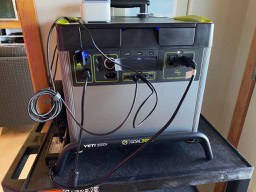
The weather is changing. If we are caught in another power outage or worse yet, an earthquake with indefinite loss of power, what would you do? The bottom line is that there are many choices of solar powered back-up battery systems. The three brands mentioned in this article are well respected. The Jackery and Goal Zero can be bought on-line or in stores such as REI or Home Depot, depending on the brand. Pricing can be vary a lot, so it pays to double check. If you have any questions, the companies seem very accessible. And the owners here on campus have allowed me to post their names as well, and can serve as advisors and references. And there are all sorts of YouTube videos comparing one power source with another. It is worth a look!
Below is a link to a chart showing typical wattage for various appliances and equipment:
https://www.donrowe.com/usage-chart-a/259.htm
for example
cell phone 10
laptop 20-75
iPad 10-20
tv-led 32” 50
tv-42 plasma 240
refrigerator 500-750
CPAP 20-60 W depending on model and accessories
Oxygen concentrators high power, 100-600 W

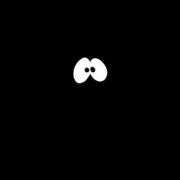


Thanks, Joni! This is helpful. Rick and I realize we need to label our equipment in case we forget the contents and instructions…and go over them once a month to stay current.